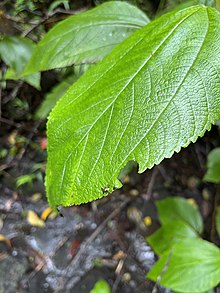KylieTastic (talk | contribs) Tag: Undo |
m I just said why my page is a reliable source to the person who keeps deleting my edits. As well you cannot have the statement in the third sentence without backing it up, which is my source and where my photos on this page come from. Just search the word ʻAkolea on my page and you will see. I explained by background and expertise in my message, and I can contribute to many more Hawaiian plant articles if I'm not constantly deleted for being "unreliable". Tags: Reverted Visual edit |
||
| Line 14: | Line 14: | ||
}} |
}} |
||
'''''Boehmeria grandis''''', commonly called '''ʻakolea''', is a flowering species of the ''Urticaceae'' family that's endemic to the Hawaiian Islands.<ref name="plantsofhawaii">{{cite web |title=Plants of Hawai'i {{!}} Bishop Museum |url=https://plantsofhawaii.org/detail/%7B6873F40E-4958-4982-BE29-701199E55707%7D |website=plantsofhawaii.org |access-date=11 September 2022}}</ref> |
'''''Boehmeria grandis''''', commonly called '''ʻakolea''', is a flowering species of the ''Urticaceae'' family that's endemic to the Hawaiian Islands.<ref name="plantsofhawaii">{{cite web |title=Plants of Hawai'i {{!}} Bishop Museum |url=https://plantsofhawaii.org/detail/%7B6873F40E-4958-4982-BE29-701199E55707%7D |website=plantsofhawaii.org |access-date=11 September 2022}}</ref> ʻAkolea can be found in mesic to wet forests across Hawaiʻi along streams, on ridges, and valley floors. Multiple sources have cited observations in Makaua Gulch on Oʻahu.<ref>{{Cite web |title=Native Hawaiian Plants: My Plant ID Guide |url=https://noahlangphotography.com/blog/native-hawaiian-plant-guide |access-date=2022-09-14 |website=noahawaii |language=en-US}}</ref><ref>{{Cite web |title=Hawaiian Native Plants, UH Botany |url=http://www.botany.hawaii.edu/faculty/carr/boehmeria.htm |access-date=2022-09-11 |website=www.botany.hawaii.edu}}</ref> |
||
Most similarily, ʻakolea can look like and be confused with its endemic counterpart Māmaki (''[[Pipturus albidus]]'') of the same family.<ref>{{cite web |title=Native Plants Hawaii - Viewing Plant : Pipturus albidus |url=http://nativeplants.hawaii.edu/plant/view/Pipturus_albidus/ |website=nativeplants.hawaii.edu |access-date=11 September 2022}}</ref> However, differences in ʻakolea's appearance come from its exerted stamens, the tightly grouped seeds on the branches of Māmaki, and subtle differences in the leaves of both that can be difficult to notice. |
Most similarily, ʻakolea can look like and be confused with its endemic counterpart Māmaki (''[[Pipturus albidus]]'') of the same family.<ref>{{cite web |title=Native Plants Hawaii - Viewing Plant : Pipturus albidus |url=http://nativeplants.hawaii.edu/plant/view/Pipturus_albidus/ |website=nativeplants.hawaii.edu |access-date=11 September 2022}}</ref> However, differences in ʻakolea's appearance come from its exerted stamens, the tightly grouped seeds on the branches of Māmaki, and subtle differences in the leaves of both that can be difficult to notice. |
||
Revision as of 06:07, 14 September 2022
| Boehmeria grandis | |
|---|---|

| |
| Scientific classification | |
| Kingdom: | Plantae |
| Clade: | Tracheophytes |
| Clade: | Angiosperms |
| Clade: | Eudicots |
| Clade: | Rosids |
| Order: | Rosales |
| Family: | Urticaceae |
| Genus: | Boehmeria |
| Species: | B. grandis
|
| Binomial name | |
| Boehmeria grandis (Hook. & Arn.) A.Heller
| |
| Synonyms[1] | |
| |
Boehmeria grandis, commonly called ʻakolea, is a flowering species of the Urticaceae family that's endemic to the Hawaiian Islands.[2] ʻAkolea can be found in mesic to wet forests across Hawaiʻi along streams, on ridges, and valley floors. Multiple sources have cited observations in Makaua Gulch on Oʻahu.[3][4]
Most similarily, ʻakolea can look like and be confused with its endemic counterpart Māmaki (Pipturus albidus) of the same family.[5] However, differences in ʻakolea's appearance come from its exerted stamens, the tightly grouped seeds on the branches of Māmaki, and subtle differences in the leaves of both that can be difficult to notice.
Ecosystem services
ʻakolea is one of the four endemic host plants for the Pulelehua (Vanessa tameamea), meaning the Pulelehua butterflies and caterpillars will only reproduce where these host plants are found.[6] Other Pulelehua host plants include Māmaki, Olonā (Touchardia latifolia), and Ōpuhe (Urera glabra) and (U. kaalae).[6]

References
- ^ "Boehmeria grandis (Hook. & Arn.) A.Heller | Plants of the World Online | Kew Science". Plants of the World Online. Retrieved 11 September 2022.
- ^ "Plants of Hawai'i | Bishop Museum". plantsofhawaii.org. Retrieved 11 September 2022.
- ^ "Native Hawaiian Plants: My Plant ID Guide". noahawaii. Retrieved 2022-09-14.
- ^ "Hawaiian Native Plants, UH Botany". www.botany.hawaii.edu. Retrieved 2022-09-11.
- ^ "Native Plants Hawaii - Viewing Plant : Pipturus albidus". nativeplants.hawaii.edu. Retrieved 11 September 2022.
- ^ a b "Host Plants". cms.ctahr.hawaii.edu. Retrieved 2022-09-11.